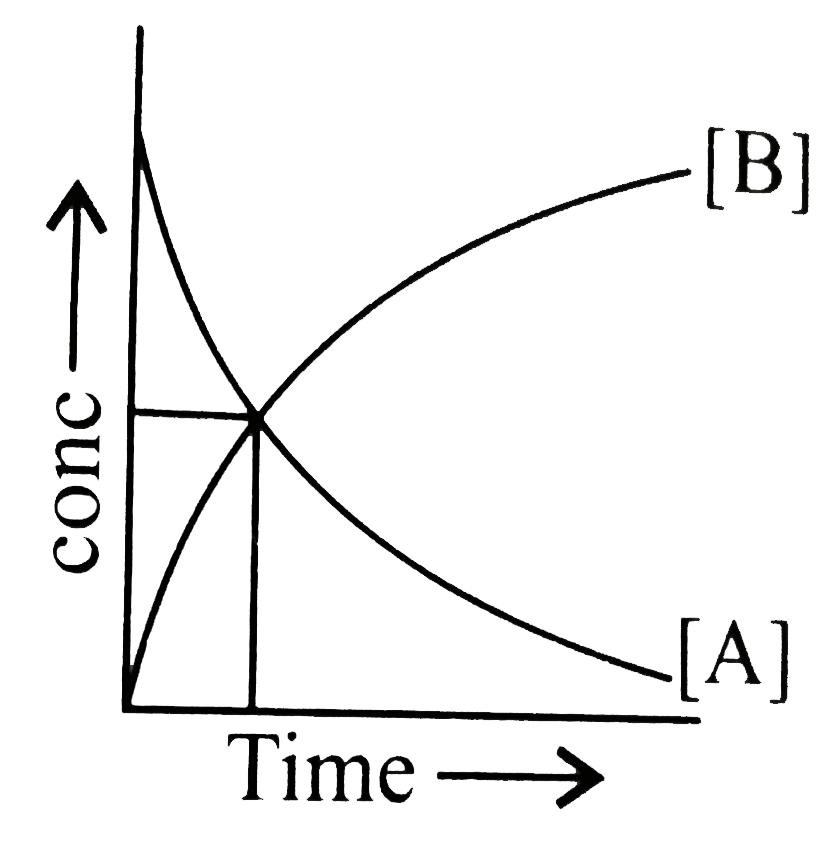The accompanying figure depicts the change in concentration of species X and Y for the reaction

X→Y, as a function of time. The point of intersection of the two curves represents:Solution in Telugu
t1/2
t3/4
t2/3
t1/4
The correct Answer is:A
x→y
A0 0
A0−x x.x=A02⇒t12
Topper's Solved these Questions
- CHEMICAL KINETICSBOOK - AAKASH SERIESCHAPTER - CHEMICAL KINETICSEXERCISE - PRACTICE SHEET-1 (LINKED COMPREHENSION TYPE QUESTIONS)
6 Videos
- CHEMICAL KINETICSBOOK - AAKASH SERIESCHAPTER - CHEMICAL KINETICSEXERCISE - PRACTICE SHEET-1 (MATCH THE FOLLOWING QUESTIONS)
2 Videos
- CHEMICAL KINETICSBOOK - AAKASH SERIESCHAPTER - CHEMICAL KINETICSEXERCISE - LEVEL-II(LECTURE SHEET EXERCISE-IV INTEGER ANSWER TYPE QUESTIONS)
10 Videos
- CHEMICAL KINETCSBOOK - AAKASH SERIESCHAPTER - CHEMICAL KINETCSEXERCISE - EXERCISE - 3.2
45 Videos
- CHEMICAL THERMODYNAMICSBOOK - AAKASH SERIESCHAPTER - CHEMICAL THERMODYNAMICSEXERCISE - Additional Practice Exercise
54 Videos
Similar Questions
The instantaneous rate of an elementary chamical reactkon aA+bB⇔cC+dD can be given by rate =Kf[A]a[B]b−Kb[C]c[D]d where Kf and Kb are rate constants for forward and backward reactions respectively for the reversible reaction. If the reaction is an irreversible one, the rate is expressed as, rate =K[A]a[B]b where K is rate contant for the given irreversible rate of disappearance of A is a/b times the rate of disappearance of B. The variation of rate constant K with temperature is expressed in terms of Arrhenius equation: K=Ae−Ea/RT whereas the ratio KfKb is expressed in terms of van't Hoff isochore: KfKb=Ae−ΔH/RT, where Ea and ΔH are energy of activation and heat of reaction respectively.
The variation of rate constant K and KfKb with temperature shows the following effects:
For endothrmic reaction when T increases then K increases and KfKb also increases.
(ii) For endothemic reaction when T decreases then K decreases and KfKb also decreases.
(iii) For exothermic when T increases then K and KfKb both increases.
(iv) For exothermic reaction when T decreases then K increases and KfKb decrease.
(v) For exothermic reaction when T increases thenK and KfKb both decrease.
View SolutionMatch the following columns

View SolutionFor the reaction A→ products the following dats is given for a particular run
time (in): 0 5 15 35
1[A](M−1):1 2 4 8
Determine the order of the reaction.
View SolutionDiscuss on the kinetic spontaneity of a chemical reaction. Is a slow reaction spontaneous? Why?
View SolutionWhich among the following is not an exact differential?
View SolutionThe number of points of intersection of the curves |y|=|ln|x|| and y=mx is two,if
View SolutionThe accompanying figure depicts a change in concentration of species A and B for the reaction A→B, as a function of time. The point of inter section of the two curves represents

View SolutionThe figure shows the change in concentration of species A and B as a function of time. The equilibrium constant K_(c) for the reaction A(g)hArr2B(g) is :
View SolutionWhat quantity is represented by the slope of the dashed line in the accompanying diagram for the concentration change in a reaction ?

View SolutionAt the point of intersection of the two curves shown for the reaction

A→nB time →
then concentration of B is given by :
View SolutionThe Given figure shows three velocity-substrate concentration curves of an enzyme reaction. What do the curves X Y and Z depict respectively ?
View SolutionConsider the curves y2=x and x2=y.
(i) Find the points of intersection of these two curves.
(ii) Find the area between these two curves.
View SolutionThe figure shows the change in concentration of species A and B as a function of time.
The equilibrium constant Kcfor the reactionA(g)⇔2B(g) is :

View SolutionThe following graph X to For the Y reaction, the concentration of X and Y changes over time, showing the point of intersection of both curves -
View SolutionIn the reaction, A+ 2B rarr 3C+D which of the following expression does not describe changes in the. concentration of various species as a function of. time:
View Solution
